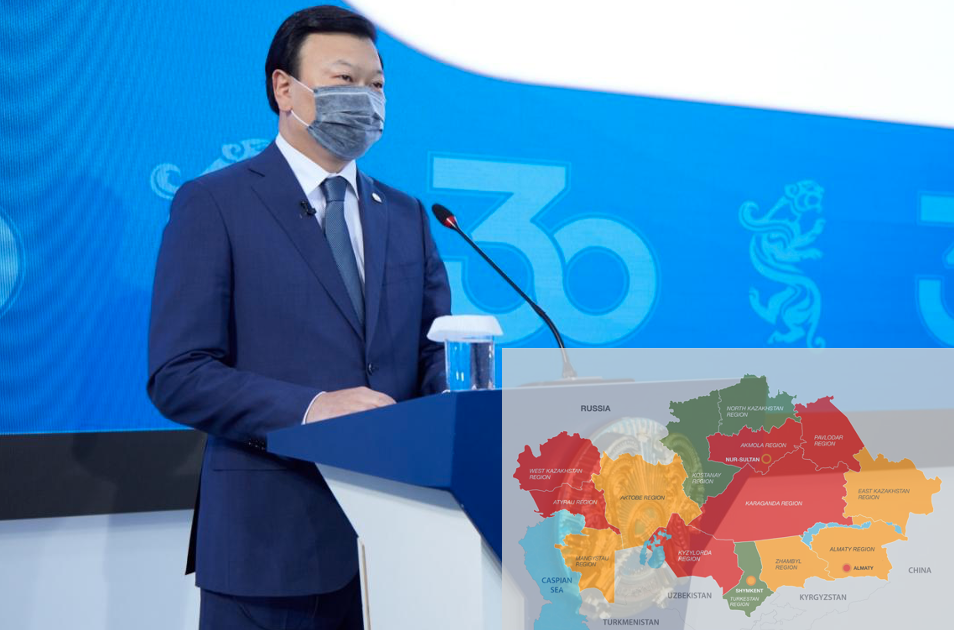NUR-SULTAN – As the vaccine rollout continues, the citizens of Kazakhstan will have access to three vaccines against COVID-19 – Russia’s Sputnik V, the locally produced QazVac, and China’s Sinopharm produced in the United Arab Emirates, said Kazakh Healthcare Minister Alexey Tsoy at an April 30 virtual meeting with the population.
“Just today we are receiving an additional Arab vaccine produced using Chinese technology by Sinopharm (named Sinopharm Hayat-Vax). Now we are also waiting for this vaccine, this vaccine will be used in the regions. So we will have three vaccines available to the population,” said Tsoy.
A new factory in Abu-Dhabi produces the Hayat-Vax vaccine using Chinese technology based on the agreement between Sinopharm and Abu Dhabi-based technology company Group 42.
Kazakhstan kicked off its mass vaccination on Feb. 1 using Russia’s Sputnik V vaccine.
From February, Kazakhstan has been using the Russian vaccine produced at a Karaganda-based pharmaceutical plant and began administering the QazVac vaccine developed by the Kazakh Biosafety Research Institute from April 26.
Similar to Sputnik V, QazVac is a two-dose vaccine administered within a 21-day interval. The first batch of 50,000 doses was dispatched to the nation’s single SK Pharmacy hub on April 23 and then distributed to the regions. Another 50,000 doses are expected to be produced in May.
According to the ministry, phase III trials of the Kazakh vaccine have already passed the 50 percent mark of the study subjects stipulated in the trial protocol, and are scheduled to be completed on June 25.
As of April 30, 1,184,124 citizens have received at least one dose, and 239,965 have been fully immunized against the virus.
Citizens receiving the full course of the vaccination received a vaccination passport through the electronic government website.
Tsoy said the passport will be integrated into the Ashyq system from July 1 giving immunized citizens a privileged “green status” with no movement restrictions.
“Vaccination data is available online. We are working with the International Air Transport Association (IATA) to integrate the vaccination passport,” said the minister.
Epidemiological situation
Since the outbreak of coronavirus infection in Kazakhstan in March 2020, there have been nearly 320,000 coronavirus cases and nearly 53,00 coronavirus pneumonia cases have been registered since August 2020. The coronavirus pneumonia exhibits coronavirus symptoms, but was not clinically confirmed as COVID-19.
Over the past day, Kazakhstan reported 2,853 new cases.
“The occupancy of infectious disease beds is currently at 42 percent and intensive care beds at 29 percent,” said Tsoy.
Currently, the cities of Nur-Sultan and Almaty and Akmola, Atyrau, West Kazakhstan, Karaganda, Kyzylorda, and Pavlodar regions are in the red zone. Shymkent city and Almaty, Aktobe, East Kazakhstan, Zhambyl, and Mangystau regions are in the yellow zone.
Only Turkistan, Kostanay, and North Kazakhstan regions are in the green zone.
New priorities for the ministry
Tsoy said the ministry had to revise its priorities amid the emerging challenges. The new priorities include improving the quality of medical services for the population within the nation’s mandatory social health insurance system, revising approaches to primary medical care, strengthening transportation of the medicine, building large modern hospitals in all regions and infectious disease hospitals, and raising salaries for medical workers.
In line with the instruction of President Kassym-Jomart Tokayev, Kazakhstan’s healthcare development program for 2020 until 2025 will be replaced by the Healthy Nation national project.
National projects are a new component of the state planning system that will be more flexible and concise compared to state programs. The officials hope their new structure and design will bring greater benefits to the population.
The main directions envisioned in the national project are the development of health care, development of a modern epidemiological forecasting and response system, domestic pharmaceutical industry, and mass sports entertainment sector.
The key target is increasing life expectancy to 75 years by 2026 from the current 73 years.
Overall, if implemented, the measures will allow for increased healthcare funding from all sources to five percent of GDP, increasing annual quotas for in vitro fertilization up to 7,000, building 20 modern medical centers in the regions, and opening 137 paramedical and midwifery stations, health posts and outpatient clinics in rural areas.
“In the proposed model, we plan to focus on the needs of the patient. Taking into account these needs, decisions should be made to improve service in healthcare organizations, and staffing of healthcare organizations according to existing needs, automation and informatization of healthcare processes,” said Tsoy.



